Main Scientific Goals
The main scientific objective of this programme is to obtain the total ozone column (TOC) and ultraviolet (UV) spectral radiation with the highest precision and long-term stability that the current technology and scientific knowledge allows to achieve. To reach this objective the group uses three interconnected areas. The base is the instrumentation; this is supported by strict QA/QC protocols that require laboratory calibrations and theoretical modelling. Finally, web- oriented databases are developed for dissemination of the observational data.
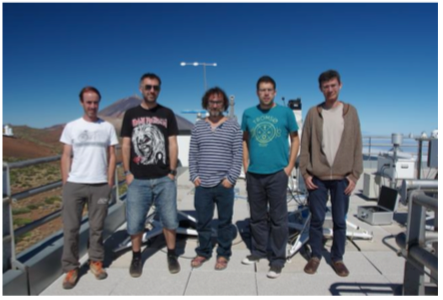
Members of the Total Ozone and UV radiation programme with the RBCC-E Brewer spectrophotometer triad located at IZO. Left to right: Virgilio Carreño, Francisco Parra Rojas, Alberto Redondas, Sergio León Luis, and Javier López Solano.
Measurement Programme
Measurements of total ozone and spectral ultraviolet radiation began in May 1991 in IZO with the installation of Brewer spectrometer #033. Ozone profile measurements were added in September 1992 with two daily (sunrise and sunset) vertical ozone profiles obtained with the Umkehr technique. In July 1997, a double Brewer #157 was installed at IZO and it ran in parallel with Brewer #033 for six months. In 2003, a second double Brewer #183 was installed and it was designated the travelling reference of the Regional Brewer Calibration Center for Europe (RBCC-E).
In 2005, a third double Brewer #185 was installed and it completes the reference triad of the RBCC-E. The measurement programme was completed with the installation of a Pandora spectroradiometer in October 2011.
Infrastructures
The infrastructures for the ozone and UV program consist basically on the terrace of the observation tower at Izana Observatory (IZO), the terrace of the Observatory at Santa Cruz (SCO), and the laboratory and ozonesonde launching platform at the Meteorological Center of Santa Cruz de Tenerife. This facility will be moved to the Botanic garden in Puerto de la Cruz (northern part of the Tenerife Island) within 2009.
Instrumentation
The technical specifications of both Brewer and Pandora instruments:
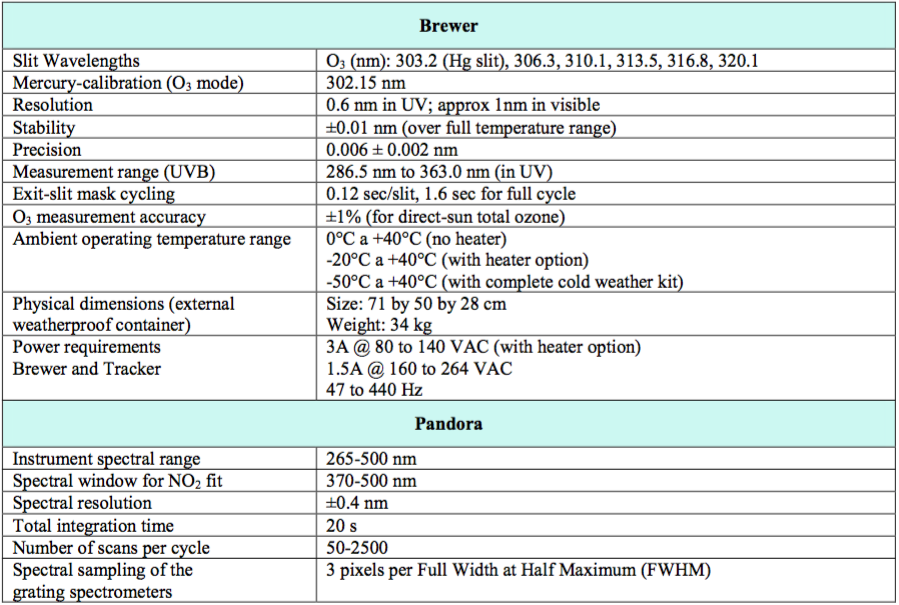
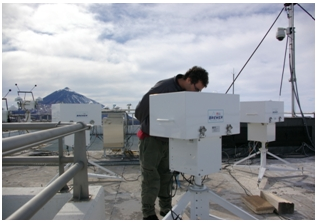
Brewer Spectroradiometers
The spectral UV measurements are routinely quality controlled using IZO calibration facilities. The stability and performance of the UV calibration is monitored by 200W lamp tests twice a month. Every six months the Brewers are calibrated in a laboratory darkroom, against 1000W DXW lamps traceable to the Word Radiation Center (WRC) standards. The SHICrivm software tool is used to analyse quality aspects of measured UV-spectra before data transfer to the databases. In addition, model to measurements comparisons are regularly done. Every year the Brewer #185 is compared with the Quality Assurance of Spectral Ultraviolet Measurements (QASUME) International portable reference spectroradiometer from Physikalisch- Meteorologisches Observatorium Davos, World Radiation Center (PMOD/WRC).
Concerning total ozone, the Brewer triad has an exhaustive quality control in order to assure the calibration, with routine calibrations performed on a monthly basis. With this procedure, we have achieved a long-term agreement between the instruments of the triad with a precision of less than 0.25% in ozone.
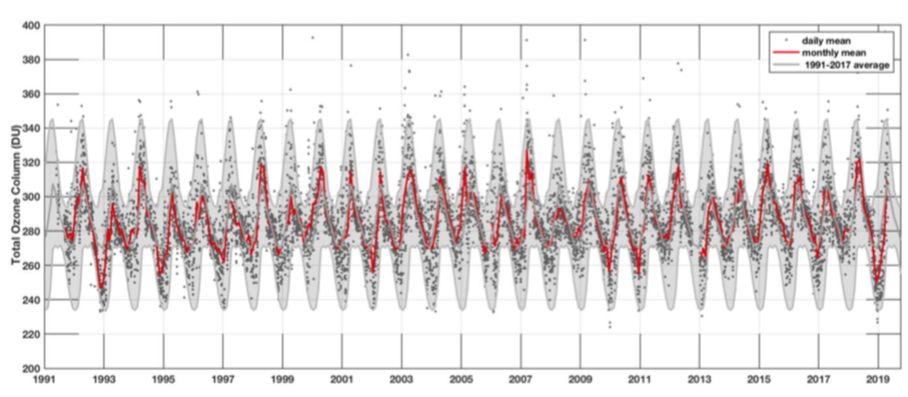
Total Ozone series at Izaña Atmospheric Observatory (1991-2018), daily mean (in grey dots) and monthly mean (in red), the long-term mean from the period 1991-2018 are also shown (grey line) with the shaded area corresponding to the standard deviation in the long term mean.
The Total Ozone programme is a part of the NDACC programme. The total ozone series for 1991-2018 is shown and is available at the NDACC website and at the World Ozone and Ultraviolet Data Center (WOUDC).
EUBREWNET
The Vienna Convention for the Protection of the Ozone Layer and the subsequent Montreal Protocol on Substances that Deplete the Ozone Layer have been among the most successful environmental agreements the nations of the world have entered into and have now almost completely eliminated the production of human-made “Ozone Depleting Substances”. This has led to the halting of the rapid decline of ozone observed in the 1980s and 1990s, with some promising early indications of ozone recovery now being apparent. It is therefore important to continue to measure carefully the state of the global ozone layer in the coming decades, noting also that stratospheric conditions are expected to change with the projected increasing concentration of greenhouse gases, and the fact that stratospheric ozone itself has a significant effect on the atmospheric radiation balance and surface climate. For this reason, the Vienna Convention obliges signatory countries to maintain programmes to systematically monitor stratospheric ozone.
The Brewer Ozone Spectrophotometer has, for the last 30 years, been the instrument of choice for ground station measurements of ozone and, in an effort to significantly improve the quality and timeliness of the data. The European Cooperation in Science and Technology (COST) Action (ES1207) was active from April 2013 to July 2017 to form a European Brewer Network – EUBREWNET. The results of this COST Action have been presented in Rimmer, Redondas, and Karppinen (2018).
Since the end of 2018, support to EUBREWNET has been provided by AEMET. The activities carried out are overseen by a committee within the WMO SAG Ozone, which includes J. Rimmer (University of Manchester, UK), A. Redondas (Izaña Atmospheric Research Centre, AEMET, Spain), T. Kralidis (WOUDC), M. Tully (O3 SAG Chair), and C. Sinclair (UV SAG Chair). Further input is provided by EUBREWNET’s Management Committee, consisting of J. Rimmer (University of Manchester, UK), A. Redondas (Izaña Atmospheric Research Centre, AEMET, Spain), A.F. Bais (Aristotle University of Thessaloniki, Greece), J. Gröbner (Physikalisch – Meteorologisches Observatorium Davos/World Radiation Center, Switzerland), T. Karppinen (Finnish Meteorological Institute, Arctic Research Center, Finland), and V. de Book (Royal Meteorological Institute of Belgium, Belgium).
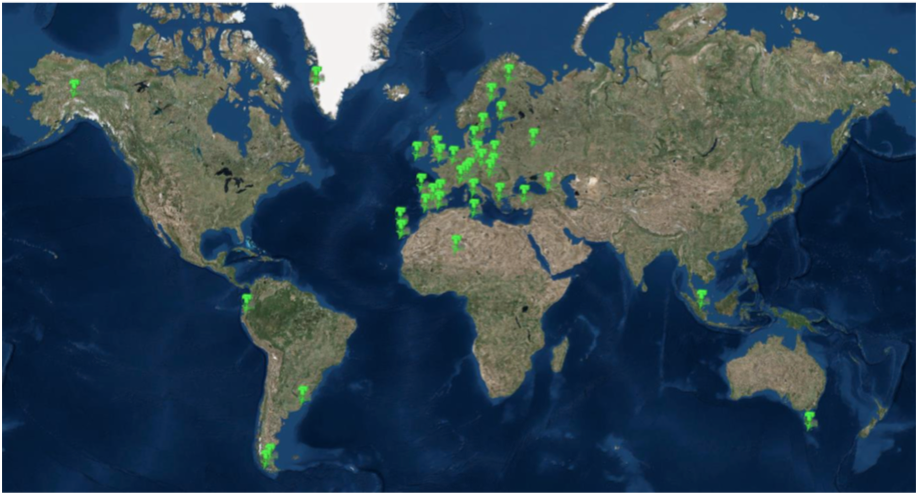
Location of Brewer stations currently participating in EUBREWNET. The network started as a European network but now includes close to 50 stations located world-wide
EUBREWNET relies on the work of two European calibration Centers, the RBCC-E and the WRC. The RBCC- E plays a key role in EUBREWNET, coordinating the standardization of operation, characterization and calibration of the network instruments as well as providing the Brewer database. Now recognised by the WMO and the International Ozone Commission (IO3C), it represents an extremely valuable network of ground station data points without which the space-borne instruments would not be able to function with any degree of accuracy. In the current times when we are trying to identify ozone recovery rates of 1% per decade, it is highly important that data are both accurate and consistent across all stations.
The purpose of EUBREWNET is to harmonise observations, data processing, calibrations and operating procedures so that a measurement at one station is entirely consistent with measurements at all the others. Additionally, the Brewer spectrophotometers are also used to measure spectral UV irradiance, the sulphur dioxide column and aerosol optical depth. Some Brewer spectrophotometers are also able to measure the nitrogen dioxide column. This harmonised Brewer network constitutes the largest harmonised g round based UV network in the world, available for assimilation into satellite retrievals and models to greatly improve accuracy of the satellite data and forecasting. Another important point is the link to climate change where tropospheric ozone and aerosols are still regarded as having the largest effect on uncertainties in climate models. The Brewer instruments are suitable for the measurement of total column ozone which includes both tropospheric and stratospheric ozone whereas satellites struggle with the lower altitudes.
During 2017-2018 EUBREWNET has facilitated other scientific studies (e.g. Carlund et al., 2017; Siani et al., 2018; Stübi et al., 2017). A full list of EUBREWNET related publications is available here.
Finally, it should be noted that EUBREWNET, in conjunction with WMO/UNEP, is very active in the areas of capacity building, particularly in Article 5 countries. This includes the organization of operator courses and workshops, which provide expert instruction and knowledge exchange using the considerable expertise within EUBREWNET
Detection of volcanic SO2 with Brewer spectrophotometers
IARC contributed to a study utilising Brewer sulphur dioxide column data (Fig. 6.6), demonstrating that SO2 columnar amounts have significantly increased following the five largest volcanic eruptions of the past decade in the Northern Hemisphere (Zerefos et al., 2017). A strong positive signal was detected by all the existing networks either ground based (Brewer, EARLINET, AirBase) or from satellites (OMI, GOME-2).
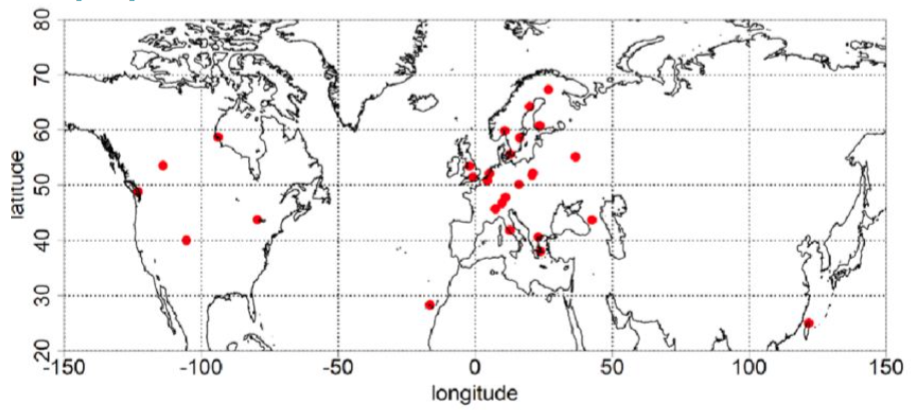
All stations with accessible SO2 column data from Brewers analysed in this study. Reprinted from Zerefos et al., (2017).
Pandonia Global Network
The Pandora Spectrometer System is a ground-based, sun/sky/lunar passive remote sensing instrument for the retrieval of trace gases in the UV/Vis spectral wavelengths. It was developed in 2005 by NASA and the Sciglob company, and since that time the Pandora spectrometer system has evolved, with the participation in a series of field campaigns such as DISCOVER-AQ, CINDI 1&2, ATMOZ 2016, and the 2018 OWLETS and LISTOS campaigns. The Pandonia Network, funded by ESA through the LuftBlick company, has unified the operative and calibration procedures for the pandora instruments since 2011.
NASA and ESA are currently collaborating to coordinate an expanding global network of standardized, calibrated Pandora instruments focused on air quality and atmospheric composition. With this collaboration the Pandonia Network has become the Pandonia Global Network (PGN), which emphasizes: homogeneous calibration of instrumentation, low instrument manufacturing and operation costs, remote operative assistance, and central data processing and formatting for near real time delivery of final data products.
A major joint objective is to support the validation and verification of more than a dozen Low Earth Orbit (LEO) and Geostationary Orbit (GEO) satellites, most notably Sentinel 5P, TEMPO, GEMS and Sentinel 4.
The reference instruments of the Pandonia Global Network will be installed at IZO, where there are already two instruments installed: Pandora 121 (Pandora 2s model, UV+VIS spectrometers, installed in April 2016) and the Pandora 101 (Pandora 1s model, UV only, installed in July 2011, but with a major hardware upgrade in July 2017). The Izaña Atmospheric Observatory is also an instrument test site together with the observation platform of the Biomedical Physics Department, Medical University Innsbruck, Austria. All the network instruments will be traceable to the reference instruments, through intercomparison with a mobile reference unit visiting network locations, while the IZO instruments will be regularly calibrated by Langley calibrations.
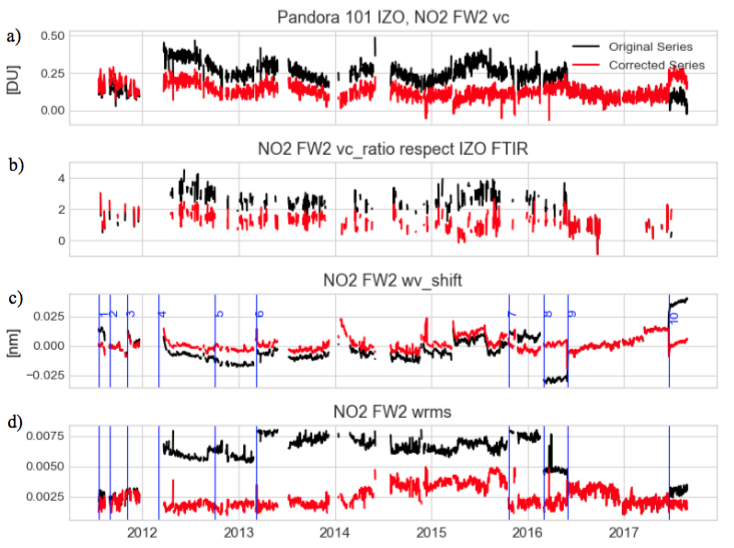
Daily means of Pandora 101 a) NO2 vertical column, b) NO2 vertical column ratio with respect to the IZO FTIR, c) NO2 wavelength shift and d) wrms of the NO2 data. Black dots correspond to the original data set, red dots correspond to the new corrected data set. Vertical lines are shown in the wv_shift and wrms plots to indicate the dates in which a correction was needed.
Collaborations with other scientific programmes
Collaborations with other scientific programmes at IARC during 2017-2018 included the following:
- Long-term Monitoring of Greenhouse Gases at the Izaña Atmospheric Observatory (García et al., 2018a)
- Comparison of observed and modeled cloud-free longwave downward radiation (2010–2016) at the high mountain BSRN Izaña station (García et al., 2018b)
- Description of the Baseline Surface Radiation Network (BSRN) station at the Izaña Observatory (2009–2017): measurements and quality control/assurance procedures (García et al., 2018c)
- Status of the Izaña BSRN station in July 2018 (García et al., 2018d)
- Improved Retrieval Strategy for Ozone Monitoring by Ground-Based FTIR Spectrometry (Sanromá et al., 2017).
Research projects.
- Budget of Ozone over the North Atlantic (BOA) (Environmental Program EV5V-CT93-0315).
- Investigation of the Oxidizing Capacity of the Atmosphere by Measurement of All Relevant Parameters Over Areas of Different Meteorological Conditions and Different Pollutional Impact (Environmental Program EV5V-CT-93-0321).
- Stratospheric Climatology Using Ultraviolet-Visible Spectroscopy (SCUVS); 1994-1996.
- Reconstruction of Vertical Ozone Distribution from Umkehr Estimates (REVUE), (Environmental Program ENV4-CT95-0161).
- Scientific UV DAta Management; EU (Environmental Program ENV4-CT95-0177).
- Standardization of Ultraviolet Spectroradiometry in Preparation of an European Network; EU (Environmental Program, ENV4-CT95-0056).
- TRansport of Chemical species Across the Subtropical tropopause (TRACAS), (Environmental Program ENV4-CT97-0546).
- Small Scale Structure Early Warning and Monitoring in Atmospheric Ozone and Related Exposure to UV-B Radiation (STREAMER), (Environmental Program ENV4-CT98-0756).
- SCOUT- O3 (Stratosphere – Climate Links With Emphasis On The UTLS)
- Medida y Modelización de la Distribución Espacio-Temporal de la Irradiancia Solar Ultravioleta en España. Programa Nacional del Clima CLI97-0345-05.
- Red Antártica para la vigilancia y Caracterización de la Radiación UltraVioleta (RACRUV). Programa Nacional de Investigación Antártica ANT98-0179.
- Control de Calidad de la Red Antártica para la vigilancia y Caracterización de la Radiación UltraVioleta (CRACRUV). Programa Nacional de Investigación Antártica REN2000-0245-C02-02.
- Determinación y predicción de la radiación ultravioleta solar en España: influencia de la columna de ozono, partículas aerosoles y nubosidad. Programa Nacional del Clima REN2000-0903-C08-02 CLI.
- Determinación y predicción de la radiación ultravioleta solar en España: Influencia de la columna de ozono, partículas aerosoles y nubosidad (DEPRUVISE) (CLI2000-0903-C08) (2001-2004).
- ROBOT (Red de Observación Brewer para la Medida Automática de Espesor Óptico de Aerosoles); Plan Nacional I+D (CGL2004-05984-C07-06).
- MANA (Red Antártica para la medida de Aerosoles); Plan Nacional I+D (CGL2004-05419-C02-02/ANT)
- TROMPETA (“TROpical Monitoring Phase in the Atmosphere”); Plan Nacional I+D (CGL2004-03669/CLI)
- UVEMA (2005- 2009): Effects of UV radiation and other environmental parameters on materials
- SAUNA; Intensive campaigns in Södankyla in Marc-April 2006 and 2007, financed by NASA
- EU Action COST 723 (“The Role of the Upper Troposphere and Lower Stratosphere in Global Change”; www.cost723.org/) thro
- EU Action “Long term changes and climatology of UV radiation over Europe”
International intercomparison campaigns (since 2005)
- An intercomparison campaign of seven UV spectroradiometers of different types took place at Izaña Observatory in June 2005. The campaign was focused primarily on spectral measurements of direct solar irradiance. Among the objectives was to improve the quality of direct solar irradiance spectral measurements, through instrumental modifications and standardization of calibration techniques, as well as to assess the significance of the differences in the field of view of the spectroradiometers with respect to aerosols and to solar zenith angle.
- In September 2005 and September 2007 were held the first and the second, respectively, Brewer intercomparison campaigns at El Arenosillo station (INTA). The scientific coordination and organization corresponded to the GAW Regional Brewer Calibration Center for Europe (RBCC-E). During the second Brewer intercomparison in 2007 a Dobson intercomparison campaign was organized by the Regional Dobson Calibration Centre-Europe (WMO-RDCC-RA-VI) Meteorological Observatory Hohenpeissenberg (Germany). During the first days both calibration campaigns performed in parallel, while the last days were used for a Dobson/Brewer comparison. In the two Brewer intercomparisons two Brewers from Morocco were fitted and calibrated.
- The third RBCC-E intercomparison was held at the Arosa Observatory (MeteoSwiss).
- The RBCC-E has hosted the first intercomparisons of the World and European Brewer and Dobson reference instruments at Izaña on September 7-27, 2008.
References
Schneider, M., A. Redondas, F. Hase, C. Guirado, T. Blumenstock, and E. Cuevas, “Comparison of ground-based Brewer and FTIR total column O3 monitoring techniques”, Atmospheric Chemistry & Physics, Vol. 8, Sep. 2008.
Schneider, M., F. Hase, T. Blumenstock, A. Redondas, and E. Cuevas, “Quality assessment of O3 profiles measured by a state-of-the-art ground-based FTIR observing system,” Atmospheric Chemistry & Physics, vol. 8, Sep. 2008.
Fioletov, V.E., G. Labow, R. Evans, E.W. Hare, U. Köhler, C.T. McElroy, K. Miyagawa, A. Redondas, V. Savastiouk, A.M. Shalamyansky, J. Staehelin, K. Vanicek, and M. Weber, “Performance of the ground-based total ozone network assessed using satellite data,” Journal of Geophysical Research (Atmospheres), vol. 113, Jul. 2008.
Redondas, A., C. Torres, O. Meinander, K. Lakkala, R. García, E. Cuevas, H. Ochoa, G. Deferrari, and S. Díaz, “Antarctic network of lamp-calibrated multichannel radiometers for continuous ozone and uv radiation data,” Atmospheric Chemistry & Physics Discussions, vol. 8, Feb. 2008.
Schoeberl, M.R., J.R. Ziemke, B. Bojkov, N. Livesey, B. Duncan, S. Strahan, L. Froidevaux, S. Kulawik, P.K. Bhartia, S. Chandra, P.F. Levelt, J.C. Witte, A.M. Thompson, E. Cuevas, A. Redondas, D.W. Tarasick, J. Davies, G. Bödeker, G. Hansen, B.J. Johnson, S.J. Oltmans, H. Vömel, M. Allaart, H. Kelder, M. Newchurch, S. Godin-Beekmann, G. Ancellet, H. Claude, S.B. Andersen, E. Kyrö, M. Parrondos, M. Yela, G. Zablocki, D. Moore, H. Dier, P. von der Gathen, P. Viatte, R. Stubi, B. Calpini, P. Skrivankova, V. Dorokhov, H. De Backer, F.J. Schmidlin, G. Coetzee, M. Fujiwara, V. Thouret, F. Posny, G. Morris, J. Merrill, C.P. Leong, G. Koenig-Langlo, and E. Joseph, “A trajectory-based estimate of the tropospheric ozone column using the residual method,” Journal of Geophysical Research (Atmospheres), vol. 112, Dec. 2007.
Oltmans, S., A. Lefohn, I. Galbally, E. Scheel, G. Bödeker, E. Brunke, H. Claude, D. Tarasick, P. Simmonds, K. Anlauf, F. Schmidlin, K. Akagi, and A. Redondas, “Long-term Changes in Tropospheric Ozone,” AGU Spring Meeting Abstracts, vol. 41, May. 2006.
Lakkala, K., A. Redondas, O. Meinander, C. Torres, T. Koskela, E. Cuevas, P. Taalas, A. Dahlback, G. Deferrari, K. Edvardsen, and H. Ochoa, “Quality assurance of the solar UV network in the Antarctic,” Journal of Geophysical Research (Atmospheres), vol. 110, Ago. 2005.
Schneider, M., T. Blumenstock, F. Hase, M. Höpfner, E. Cuevas, A. Redondas, and J.M. Sancho, “Ozone profiles and total column amounts derived at Izana, Tenerife Island, from FTIR solar absorption spectra, and its validation by an intercomparison to ECC-sonde and Brewer spectrometer measurements,” Journal of Quantitative Spectroscopy and Radiative Transfer, vol. 91, Mar. 2005.
Martínez-Lozano, J.A., M.J. Marín, F. Tena, M.P. Utrillas, L. Sánchez-Muniosguren, C. González-Frías, E. Cuevas, A. Redondas, J. Lorente, X. Cabo, V. Cachorro, R. Vergaz, A. Frutos, J.P. Díaz, F.J. Expósito, B. Morena, and J.M. Vilaplana, “UV Index Experimental Values During the Years 2000 and 2001 from the Spanish Broadband UV-B Radiometric Network” Photochemistry and Photobiology, vol. 76, 2002.
Cuevas, E., M. Gil, J. Rodríguez, M. Navarro, and P. Hoinka, Sea-land total ozone differences from TOMS: The GHOST effect, J. Geophys. Res., Vol. 106, D21, p.p. 27745-27755, 2001.
de Backer, H., P. Koepke, A. Bais, X. de Cabo, T. Frei, D. Gillotay, C. Haite, A. Heikkil, A. Kazantzidis, T. Koskela, E. Kyrö, B. Lapeta, J. Lorente, K. Masson, B. Mayer, H. Plets, A. Redondas, A. Renaud, G. Schauberger, A. Schmalwiesser, H. Schwander, and K. Vanicek, “Comparison of measured and modelled uv indices for the assessment of health risks,” Meteorological Applications, vol. 8, Sep. 2001.
Bais, A.F., B.G. Gardiner, H. Slaper, M. Blumthaler, G. Bernhard, R. McKenzie, A.R. Webb, G. Seckmeyer, B. Kjeldstad, T. Koskela, P.J. Kirsch, J. Gröbner, J.B. Kerr, S. Kazadzis, K. Leszcznski, D. Wardle, W. Josefsson, C. Brogniez, D. Gillotay, H. Reinen, P. Weihs, T. Svenoe, P. Eriksen, F. Kuik, and A. Redondas, “SUSPEN intercomparison of ultraviolet spectroradiometers,” Journal of Geophysical Research, vol. 106, Jun. 2001.
Gröbner, J., R. Vergaz, V.E. Cachorro, D.V. Henriques, K. Lamb, A. Redondas, J.M. Vilaplana, and D. Rembges, “Intercomparison of aerosol optical depth measurements in the UVB using Brewer spectrophotometers and a Li-Cor spectrophotometer,” Geophysical Research Letters, vol. 28, May. 2001
Schulz, A., Rex, M., Harris, N. R. P., Braathen, G. O., Reimer, E., Alfier, R., Kilbane-Dawe, I., Eckermann, S., Allaart, M., Alpers, M., Bojkov, B., Cisneros, J., Claude, H., Cuevas, E., Davies, J., De Backer, H., Dier, H., Dorokhov, V., Fast, H., Godin, S., Johnson, B., Kois, B., Kondo, Y., Kosmidis, E., Kyrö, E., Litynska, Z., Mikkelsen, I. S., Molyneux, M. J., Murphy, G., Nagai, T., Nakane, H., O’Connor, F., Parrondo, C., Schmidlin, F. J., Skrivankova, P., Varotsos, C., Vialle, C., Viatte, P., Yushkov, V., Zerefos, C., von der Gathen, P., Arctic ozone loss in threshold conditions: Match observations in 1997/1998 and 1998/1999, J. Geophys. Res., 106, D7, 7495-7503, 2001.
Díaz, J.P., F.J. Expósito, C.J. Torres, V. Carreño, and A. Redondas, “Simulation of mineral dust effects on UV radiation levels,” Journal of Geophysical Research, vol. 105, 2000.
Armerding, W., F.J. Comes, H.J. Crawack, O. Forberich, G. Gold, C. Ruger, M. Spickermann, J. Walter, E. Cuevas, A. Redondas, R. Schmitt, and P. Matuska, “Testing the daytime oxidizing capacity of the troposphere: 1994 OH field campaign at the Izaña observatory, Tenerife,” Journal of Geophysical Research, vol. 102, May. 1997.
Berjón, A., Redondas, A., Sildoja M-M, Nevas S, Carreno V, Santana-Díaz D, Hernández-Cruz B, León-Luis SF, López- Solano J. Temperature characterisation of Brewer determined in the laboratory. Talk presented at the ATMOZ Final Workshop, Huelva, Spain, 2 June 2017. (Available at: https://projects.pmodwrc.ch/atmoz/images/huelva_workshop/3 .pdf)
Berjón, A., Redondas, A., Sildoja, M.-M., Nevas, S., Wilson, K., León-Luis, S. F., El Gawhary, O., and Fountoulakis, I. Sensitivity study of the instrumental temperature corrections on Brewer total ozone column measurements, Atmos. Meas. Tech., https://doi.org/10.5194/amt-11-3323-2018, 11, 3323- 3337, 2018.
Carlund, T., Kouremeti, N., Kazadzis, S. and Gröbner, J.: Aerosol optical depth determination in the UV using a four-channel precision filter radiometer, Atmos. Meas. Tech., 10(3), 905– 923, doi:10.5194/amt-10-905-2017, 2017.
Cede, A., Manual for Blick Software Suite 1.6. Available at: http://pandonia.net/media/documents/BlickSoftwareSuite_Ma nual_v11.pdf, 2019.
El Gawhary, O., Van der Leden, N., Berjón, A., Redondas, A., Egli, L., Kröger, I., Sperfeld, P., and Gröbner, J.; Operation of a wavelength ruler for the characterization of spectroradiometers for O3 measurement at the 2016 Izaña field campaign, UVNews 12, 29–31, 2017a. (Available at: http://metrology.tkk.fi/uvnet/reports.htm).
El Gawhary O, Redondas A, Parra-Rojas F. Uncertainties in TOC retrieval for Brewer and Dobson data and the role of cross- correlations among influence parameters. Talk presented at the ATMOZ Final Workshop, Huelva, Spain, 2 June 2017b.
Fountoulakis I., A. Redondas, K. Lakkala, A. Berjon, A.F. Bais, L. Doppler, U. Feister, A. Heikkila, T. Karppinen, J.M. Karhu, T. Koskela, K. Garane1, K. Fragkos, and V. Savastiouk. Temperature dependence of the Brewer global UV measurements. Atmos. Meas. Tech., https://doi.org/10.5194/amt-10-4491-2017, 10, 4491-4505, 2017.
García, O.E., E. Sepúlveda, E. Cuevas, A.J. Gómez-Peláez, M. Schneider, F. Hase. T. Blumenstock, A. Redondas, and V. Carreño, Long-term Monitoring of Greenhouse Gases at the Izaña Atmospheric Observatory, 14th International Workshop on Greenhouse Gas Measurements from Space (IWGGMS-14), Toronto (Canada), 8-10 May, 2018a.
García, R. D., Barreto, A., Cuevas, E., Gröbner, J., García, O. E., Gómez-Peláez, A., Romero-Campos, P. M., Redondas, A., Cachorro, V. E., and Ramos, R. Comparison of observed and modeled cloud-free longwave downward radiation (2010– 2016) at the high mountain BSRN Izaña station, Geosci. Model Dev., https://doi.org/10.5194/gmd-11-2139-2018, 11, 2139- 2152, 2018b.
García, R. D., Cuevas, E., Ramos, R., Cachorro, V. E., Redondas, A., and Moreno-Ruiz, J. A.: Description of the Baseline Surface Radiation Network (BSRN) station at the Izaña Observatory (2009–2017): measurements and quality control/assurance procedures, Geosci. Instrum. Method. Data Syst. Discuss., https://doi.org/10.5194/gi-2018-41, 2018c.
García, R.D., E. Cuevas, R. Ramos, V.E. Cachorro, and A. Redondas, Status of the Izaña BSRN station in July 2018, 15th BSRN Scientific Review and Workshop at CIRES, Boulder CO, USA July, 16-20, 2018d.
Gröbner, J., Kröger, I., Egli, L., Hülsen, G., Riechelmann, S., Sperfeld, P. The high-resolution extraterrestrial solar spectrum (QASUMEFTS) determined from ground-based solar irradiance measurements. Atmos. Meas. Tech., 10, 3375-83, 2017a.
Gröbner, J., Redondas, A., Weber, M., Bais, A. Final Publishable Report Traceability for atmospheric total column ozone (ENV59, ATMOZ). EURAMET; 2017b. (Available at: https://www.euramet.org/research-innovation/search-research- projects/details/project/traceability-for-atmospheric-total- column-ozone/)
Köhler, U., Nevas, S., McConville, G., Evans, R., Smid, M., Stanek, M., Redondas, A., and Schönenborn, F.: Optical characterisation of three reference Dobsons in the ATMOZ Project – verification of G. M. B. Dobson’s original specifications, Atmos. Meas. Tech., 11, 1989-1999, https://doi.org/10.5194/amt-11-1989-2018, 2018.
Kurucz, R. L. New atlases for solar flux, irradiance, central intensity, and limb intensity. Memoriedella Societa Astronomica Italiana Supplementi, 8:189, 2005.
Lakkala, K., Arola, A., Gröbner, J., León-Luis, S. F., Redondas, A., Kazadzis, S., Karppinen, T., Karhu, J. M., Egli, L., Heikkilä, A., Koskela, T., Serrano, A. and Vilaplana, J. M.: Performance of the FMI cosine error correction method for the Brewer spectral UV measurements, Atmospheric Measurement Techniques, 11(9), 5167–5180, doi:https://doi.org/10.5194/amt-11-5167-2018, 2018a.
Lakkala, K., Redondas, A., Meinander, O., Thölix, L., Hamari, B., Almansa, A. F., Carreno, V., García, R. D., Torres, C., Deferrari, G., Ochoa, H., Bernhard, G., Sanchez, R., and de Leeuw, G. UV measurements at Marambio and Ushuaia during 2000–2010, Atmos. Chem. Phys., https://doi.org/10.5194/acp- 18-16019-2018, 18, 16019-16031, 2018b.
León-Luis, S. F., Redondas, A., Carreño, V., López-Solano, J., Berjón, A., Hernández-Cruz, B., and Santana-Díaz, D., Internal consistency of the Regional Brewer Calibration Centre for Europe triad during the period 2005–2016. Atmos. Meas. Tech., https://doi.org/10.5194/amt-11-4059-2018, 11, 4059- 4072, 2018a.
León-Luis, S.F., Carreño, V., Redondas, A., Santana-Díaz, D., López-Solano, J., Rodríguez-Válido, M. Centro de Calibración Regional Brewer – Europa (RBCC-E): Estabilidad de las medidas de ozono realizadas en el Observatorio Atmosférico de Izaña. Acta de las XXXV Jornadas Científicas de la Asociación Meteorológica Española. León, Spain, 5-7 March 2018, https://doi.org/10.30859/ameJrCn35p213, 2018b.
León-Luis, S.F., Carreño, V., Redondas, A., Henriques, D., Moniz, L. Campaña intercomparación Brewer 2017: Calibración del Brewer #102. Acta de las XXXV Jornadas Científicas de la Asociación Meteorológica Española. León, Spain, 5-7 March 2018, https://doi.org/10.30859/ameJrCn35p219, 2018c.
López-Solano, J., Redondas, A., Carlund, T., Rodriguez-Franco, J. J., Diémoz, H., León-Luis, S. F., Hernández-Cruz, B., Guirado- Fuentes, C., Kouremeti, N., Gröbner, J., Kazadzis, S., Carreño, V ., Berjón, A., Santana-Díaz, D., Rodríguez-V alido, M., De Bock, V., Moreta, J. R., Rimmer, J., Smedley, A.R.D., Boulkelia, L., Jepsen, N., Eriksen, P., Bais, A. F., Shirotov, V., Vilaplana, J. M., Wilson, K. M., and Karppinen, T. Aerosol optical depth in the European Brewer Network, Atmos. Chem. Phys., https://doi.org/10.5194/acp-18-3885-2018, 18, 3885- 3902, 2018a.
López-Solano, J., Redondas, A., Carlund, T., Rodriguez-Franco, J. J., Diémoz, H., León-Luis, S. F., Hernández-Cruz, B., Guirado- Fuentes, C., Kouremeti, N., Gröbner, J., Kazadzis, S., Carreño, V., Berjón, A., Santana-Díaz, D., Rodríguez-Valido, M., De Bock, V., Moreta, J. R., Rimmer, J., Smedley, A.R.D., Boulkelia, L., Jepsen, N., Eriksen, P., Bais, A. F., Shirotov, V., Vilaplana, J. M., Wilson, K. M., and Karppinen, T., UV Aerosol Optical Depth in the European Brewer Network, 9th International Workshop on Sand/Dust storms and Associated Dustfall, La Laguna, Tenerife, Spain, 22-24 May 2018b.
Redondas, A. South Europe Regional Report: Armenia, Italy, Spain & Turkey. The 10th meeting of the Ozone Research Managers of the Parties to the Vienna Convention, Geneva, 28- 30 March 2017a.
Redondas, A. ATMOZ. Izaña Ozone Campaign. Talk presented at the ATMOZ Final Workshop, Huelva, Spain, 2 June 2017b. (Available at: https://projects.pmodwrc.ch/atmoz/images/huelva_workshop/9 .pdf)
Redondas, A., Santana-Díaz D, Cede A, Tiefengraber M. Pandonia updates and overview. Talk presented at the ATMOZ Final Workshop, Huelva, Spain, 2 June 2017. (Available at: https://projects.pmodwrc.ch/atmoz/images/huelva_workshop/1 1.pdf)
Redondas, A., Carreño, V., León-Luis, S.F., Hernández-Cruz, B., López-Solano, J., Rodriguez-Franco, J.J., Vilaplana, J.M., Gröbner, J., Rimmer, J., Bais, A.F., Savastiouk, V., Moreta, J.R., Boulkelia, L., Jepsen, N., Wilson, K. M., Shirotov, V., and Karppinen, T. EUBREWNET RBCC-E Huelva 2015 Ozone Brewer Intercomparison, Atmos. Chem. Phys, https://doi.org/10.5194/acp-18-9441-2018, 18, 9441-9445, 2018.
Redondas, A., Nevas, S., Berjón, A., Sildoja, M.-M., León-Luis, S. F., Carreño, V., and Santana-Díaz, D. Wavelength calibration of Brewer spectrophotometer using a tunable pulsed laser and implications to the Brewer ozone retrieval, Atmos. Meas. Tech., https://doi.org/10.5194/amt-11-3759-2018, 11, 3759-3768, 2018.
Rimmer, J. S., Redondas, A., Groebner, J., Karprinen, T., de Bock, V., Bais, A. The European COST Action EUBrewNet: Towards consistency in quality control, quality assurance and coordinated operations of the Brewer Instrument. The 10thmeeting of the Ozone Research Managers of the Parties to the Vienna Convention, Geneva, 28 – 30 March 2017.
Rimmer, J. S., Redondas, A., and Karppinen, T. EuBrewNet – A European Brewer network (COST Action ES1207), an overview., Atmos. Chem. Phys., 18, 10347-10353, https://doi.org/10.5194/acp-18-10347-2018, 2018.
Siani, A. M., Frasca, F., Scarlatti, F., Religi, A., Diémoz, H., Casale, G. R., Pedone, M. and Savastiouk, V.: Examination on total ozone column retrievals by Brewer spectrophotometry using different processing software, Atmos. Meas. Tech., 11(9), 5105–5123, doi:10.5194/amt-11-5105-2018, 2018.
Stübi, R., Schill, H., Klausen, J., Vuilleumier, L. and Ruffieux, D.: Reproducibility of total ozone column monitoring by the Arosa Brewer spectrophotometer triad, Journal of Geophysical Research: Atmospheres, 122(8), 4735–4745, doi:10.1002/2016JD025735, 2017.
Thuillier, G., L Floyd, T N Woods, R Cebula, E Hilsenrath, M Hersé, and D Labs. Solar irradiance referencespectra for two solar active levels. Advances in Space Research, 34(2):256– 261, 2004.
Vandaele, A.C., Hermans, C., Simon, P.C., Carleer, M., Colin, R., Fally, S., Mérienne, M.F., Jenouvrier, A., Coquart B. Measurements of the NO2 absorption cross-section from 42 000 cm−1 to 10 000 cm−1 (238–1000 nm) at 220 K and 294 K. Journal of Quantitative Spectroscopy and Radiative Transfer, 59, 171-184, doi: 10.1016/S0022-4073(97)00168-4, 1998.
Zerefos, C. S., Eleftheratos, K., Kapsomenakis, J., Solomos, S., Inness, A., Balis, D., Redondas, A., Eskes, H., Allaart, M., Amiridis, V ., Dahlback, A., De Bock, V ., Diémoz, H., Engelmann, R., Eriksen, P., Fioletov, V., Gröbner, J., Heikkilä, A., Petropavlovskikh, I., Jarosławski, J., Josefsson, W., Karppinen, T., Köhler, U., Meleti, C., Repapis, C., Rimmer, J., Savinykh, V., Shirotov, V., Siani, A. M., Smedley, A. R. D., Stanek, M., and Stübi, R.: Detecting volcanic sulfur dioxide plumes in the Northern Hemisphere using the Brewer spectrophotometers, other networks, and satellite observations, Atmos. Chem. Phys., 17, 551-574, doi:10.5194/acp-17-551- 2017, 2017.
Staff
Alberto Redondas Marrero (AEMET; Head of programme)
Virgilio Carrreño (AEMET; Meteorological Observer- GAW Technician)
Dr Sergio Fabián León Luis (AEMET; Research Scientist) Dr Alberto Berjón (TRAGSATEC; Research Scientist)
Dr Javier López Solano (TRAGSATEC; Research Scientist)
Daniel Santana Díaz (Sieltec/LuftBlick; Pandonia Global Network Operator/Research Scientist)
Dr Francisco Parra Rojas (UIAPR; Research Professor)
Bentorey Hernandez Cruz (ULL; Research Scientist) left IARC in July 2018
